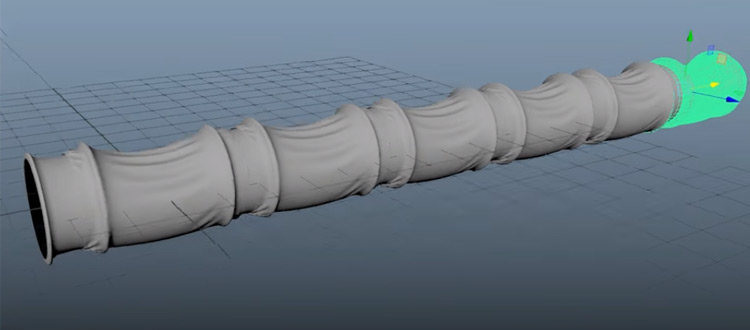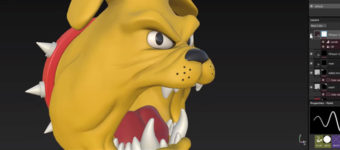Best Free Marvelous Designer Tutorials For CG Artists
Marvelous Designer is a dedicated 3D clothing simulation program that lets CG artists create garments ranging from a simple shirt to complicated Victorian dresses.
This is a really versatile program not just limited to character clothing. You can design fabrics for any objects such bags, carpets, furniture, curtains, and more.
With no close competitor, Marvelous Designer has been a go-to program for clothing creation for films and games. Much in the same way that Substance Painter is now a go-to program for 3D texturing.
In this series of free tutorials you’ll learn how to create patterns, simulate garments, and art direct your very own outfits.
What’s great about this is you don’t need to be a tailor or have any prior real-life experience with fabrics. If you’ve got a love for 3D & CG work you can be sewing digital masterpieces in no time!
Beginner Marvelous Tutorial
In this comprehensive 48-minute tutorial, Lori Griffiths teaches you the fundamentals of Marvelous Designer by creating a simple dress from its bodice down to the skirt.
This is aimed towards users with no prior experience in the software, AKA it’s great for beginners.
The author also discusses common pitfalls that beginners face such as unfolding garments that are not aligned to the grid, or zooming too close to the viewport which renders garments out of frame.
You’ll also appreciate the demonstration where you can actually interact with the garment while it’s being simulated.
Undoubtedly, this is the oldest video tutorial in this list but this covers a lot and provides more value to the unsuspecting novice. If you’re in a pinch and can only watch one video, this should be it.
Lori Griffiths is also one of the only artists on YouTube who has produced a record high number of free Marvelous Designer tutorials. You can check her YouTube channel for more.
Lori also wrote the first and only dedicated Marvelous Designer book, if you’re more of a reader.
Starting in Marvelous Designer 7
Learn how to make a simple bodycon dress while learning the basics of Marvelous Designer.
You’ll pick up how to add an avatar with MD7, since in recent versions this is not added by default. You’ll also explore basic navigation modes and different viewport displays such as wireframe and textured viewing settings.
This short demonstration aims to teach you the basics, along with how to troubleshoot your simulation by modifying patterns such as converting hard points to curves to achieve a tighter fit.
You can check the author’s YouTube channel for more Marvelous Designer short tutorials.
First Fabrics
FlippedNormals shows us how to create a sleek casual attire from scratch.
You’ll learn how to adjust your patterns to create a decent fit which is crucial for character design.
You’ll also learn how to modify your garments by adding points(or split lines). Little features such as aligning points to the X and Y axis, or snapping angles by holding the shift key, will surely improve your workflow.
FlippedNormals provides high quality free and premium tutorials for all stages of the 3D pipeline. You can check their YouTube channel and browse around to see if anything grabs your attention.
Creating a T-Shirt
In this comprehensive tutorial you’ll learn how to create a plain old t-shirt.
While it is a simple garment and can easily be simulated, it also forces newbies to stumble into common pitfalls.
Every now and then Marvelous Designer creates a perfect fit that is a tell-tale of a CG creation. After this tutorial you’ll learn how to avoid issues by adding custom folds and dragging garments while simulating.
You’ll also learn how to unfold garments to create a symmetrical pattern along with a curve point to match the bodice and sleeves pattern.
Create a Sporty Outfit
So this is a long one and well worth the time.
In this comprehensive 50-minute tutorial you’ll follow Travis David through a sporty outfit design.
Usually artists rely on Marvelous Designer to create folds and not necessarily a perfect fit. This tutorial is a good case study on how flexible Marvelous Designer can be, since it can create both!
You’ll learn time-saving techniques such as creating a hole from an internal outline, using the clone symmetry command, and exploring the steam brush which lets you to create tight or excess fabric without modifying the underlying pattern.
Game Character Pants
Most examples using Marvelous Designer features a best case scenario avatar where the limbs are in proportion or posed in a picture perfect stand still.
How about if you have to deal with a fictional creature with unusual features?
This tutorial explores just that.
You’ll learn to properly approach this challenging task by first sewing a “belt” pattern that lets you sew other patterns onto it.
This is a nondestructive workflow and allows for a much more stable result.
You’ll also learn what happens when you sew the wrong direction of the garment and how to solve it. Plus as you work through the lesson you’ll understand how to interpret the tension map for a more guided sewing experience.
Single-Fold Helm
Unlike the other entries in this list, this tutorial focuses on a specific sewing technique that can be applied to various garments.
The single-fold helm is commonly used at the edge of fabric to properly close the garment and eventually prevent unthreading.
This added detail will certainly give your model the true-to-life production value it needs.
To achieve this effect you’ll be using the offset internal line command and making sure the extend parameter is ticked off.
You’ll learn how to accelerate your simulation by freezing patterns, making detailed folds by decreasing particle distance, and manipulating garment direction with the fold arrangement tool.
Lots of really cool technical stuff in this one if you’re up for a challenge.
Full Warrior Robe
Ever wanted to design a complete Jedi attire with robe?
Well now you can – with ease. This handy video teaches you how to separates patterns in half, stitch a two-piece to a four-piece garment and eventually utilize the cut and sew command to add more detail on your clothes’ edges.
If you are interested in other fictional attires such as the gown from Lord of the Rings, you can check one other nifty tutorial here.
How To Make Curtains (Easy)
In the old days of 3D modeling you’d need various splines in creating a loft to resemble a curtain.
It was painful and tedious, especially when revision notes come around from the higher ups.
But with the help of Marvelous Designer curtain problems are a thing of the past.
In this short tutorial you can pick up the basics on how to create pleasing folds by having uneven sizes of patterns. You’ll also learn how to manage your simulation by freezing a specific garment in place.
Practice along with this tutorial and make your interior renders feel more authentic every time.
How To Create a Comforter
Add spice to any bedroom scene by dropping in a realistic comforter.
What used to be just for limited poses, can now be used for any scene given enough time.
With the same technique used for puffy jackets, Mike Hermes takes you through several workflows such as utilizing the pressure parameters and using several internal lines.
Mike Hermes also takes audience requests for tutorial ideas. So if you have a question that is not yet explored properly hit him up on his YouTube channel and see if he’ll provide a little more.
Cloth Simulation Tools + 3ds Max
The more time you spend in Marvelous Designers the more you’ll realize how well it works alongside 3ds Max.
What makes this tutorial different is the focus on how cloth plays a role in architectural visualization. This video answers an important question for CG fabric work: what is the equivalent of an avatar in Marvelous Designer to 3ds Max?
Throughout the video you’ll be making cushions while also learning how to modify cloth properties such as shrinkage weft and warp.
He also demonstrates how pinning cloth helps while simulating. The author brings out another advantage of using Marvelous Designer in a production flow: the option to export in quads(as opposed to tris) and generate the exact UV as that of your garment. Pretty cool!
Create a Simple Dress
Travis David holds your hand here and takes you through making a simple dress.
In this tutorial you’ll learn how to use the curvature tools to create those accentuated curves for your character. For anyone still intimated with Marvelous Designer, Travis reassures that making a pattern from an image is just like connecting dots. Anyone can do it given enough practice.
Lastly he shows how the back and front of a pattern can be totally different and still fit.
So many golden nuggets in this video and it’s especially great for newbies.
Workflow Webinar
In this 2-hour webinar, senior character artist Marlon Nuñez breaks down his workflow for using Marvelous Designer to create detailed garments for his characters.
By the end of the demonstration you’ll be able to create a realistic jacket and you’ll have learned a ton about the software.
There is simply no comparison to watching a professional work live in real time.
He begins by discussing how important it is to use references and reminds you that cloth patterns are not as straightforward as they look. Marlon is even generous enough to share which sites he uses for patterns.
Also he shows how easy it is to add pockets into garments by just creating an internal shape, copying the pattern, and sewing them back together.
He also cautions viewers that while Marvelous Designers generates believable attire, it is not the end of the process. More often than not you will need to take the output to Zbrush for detailing and eventually to a dedicated 3D package for retopology.
You can check more of his artwork and professional projects on his ArtStation page.
Creating Overalls

Madina Chionidi, former lead of EA Dice, breaks down how to create jean overalls in this super detailed guide.
Not an easy garment to model but certainly a manageable task. Please note: this is not a video tutorial, but rather a written guide you would follow step-by-step.
Still the content is so helpful that you really should give it a try.
What makes Madina’s guide a little different is the actual use of patterns. While you can certainly get away with makeshift patterns, having a realistic base goes a long way.
And one of the hardest parts of diving into Marvelous Designer is not actually the software, but finding patterns. In the last part of the guide be sure to take note of her resources section!
Now if you’ve followed all these guides and you’re ready for advanced tutorials then check out Madina’s Gumroad page with a bunch of awesome(and cheap!) fabric design tutorials.













